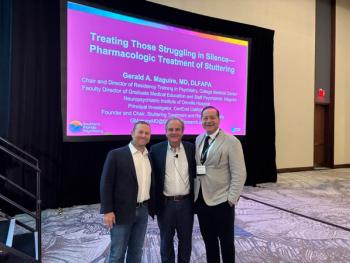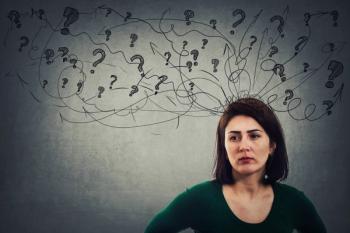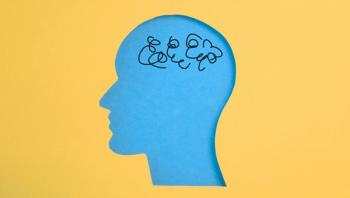
- Vol 39, Issue 10
Neurobiological Mechanisms of Mind-Body Medicine
"Rooted in ancient meditative traditions, mind-body practices can offer simple and scalable tools of self-regulation that incorporate controlled paced breathing, which is therapeutic in alleviating symptoms of stress, anxiety, depression, and chronic pain disorders."
SPECIAL REPORT: INTEGRATIVE MEDICINE
Clinical Case Vignette
In our post–COVID-19 clinic, we utilize mind-body practices to reduce stress of COVID-19 and long COVID–related illnesses with breath-based practices of individual choice; these include brief yogic practices, yoga classes, tai chi classes, and brief breathing exercises of 5 to 10 minutes a day using a “boxed” breath of 3-3-3-3 or 4-4-4-4 to arrive at 4 to 6 breaths per minute, which are well studied and documented to reduce blood pressure and heart rate by activating parasympathetic vagal response and reducing sympathetic overdrive.
“Ms Arnold” is a 23-year-old recent college graduate undergoing a competitive internship at a television production company who presented with complaints of brain fog, anxiety, insomnia, and headaches following 2 repeated COVID-19 infections in the past year. Among several choices of mind-body practices, she selected brief breathing practices and grounding exercises, as well as taking time to connect with nature to reduce anxiety and insomnia and help clear her mind that was now lacking “a capacity for creative thought.”
She practiced on the weekends and at work when experiencing anxiety. After approximately 2 weeks, she reported a greater sense of calm and an improved ability to regulate and reduce anxiety that was also helpful in reducing both her fear of failing at her job and her insomnia. This practice provided her with a lifelong tool for self-regulation and stress-reduction techniques.
Our collective
Approaches that are minimally invasive, cost-effective, culturally acceptable, and scalable are essential to the successful management of global mental health needs.
For thousands of years, ancient Eastern contemplative practices have been used by humans to expand consciousness, obtain enlightenment, and connect to one’s spiritual nature, as well as to balance mental and physical health and maintain longevity. In recent times in the West, these practices have been used by millions of individuals for reducing stress, enhancing well-being, and improving coping with chronic diseases of aging.
Rooted in ancient meditative traditions, mind-body practices can offer simple and scalable tools of self-regulation that incorporate controlled paced breathing (eg,
At the same time, the public has demonstrated a growing interest in the tools for self-regulation and acceptance of these ancient meditative practices. Recent surveys indicate roughly 15% to 19% of US adults are engaged in meditative and yoga practices. Rates among those with a mental health disorder—most commonly anxiety, stress, and depression—are even higher.4 Yet without clear understanding of the underlying neural and physiological mechanisms, development of better treatments is difficult, especially with a goal of optimal personalized options per the National Institutes of Health Precision Medicine Initiative.
Meditative practices (eg, mindfulness-based therapies, transcendental meditation, mantra meditation, and yoga) have demonstrated efficacy for enhancing mental health in a range of clinical and healthy populations.5 Meditative therapies confer a lower risk of adverse effects compared with more invasive approaches, have been shown to reduce adverse effects associated with pharmacological treatment,6 and have potential to build lifelong skills with benefits far beyond initial training.
Both meditative movement (eg, yoga) and multicomponent mindfulness-based interventions (eg, mindfulness-based cognitive therapy and mindfulness-based relapse prevention) appear at least as effective as other active treatments for disorders such as major depression and substance use disorder.
In healthy adults, studies suggest that multicomponent interventions such as mindfulness-based stress reduction have potential to increase empathy, self-control, self-compassion, relationship quality, and spirituality and to decrease rumination.7 Translational neuroscience of mind-body therapies has also begun to evaluate the neurobiological mechanisms by which meditative therapies enhance resilience to mental health disorders, and several promising mechanistic domains have been identified (
Neurobiological Mechanisms
As a whole, meditative therapies appear effective for improving psychological well-being across a wide range of populations. However, the psychological mechanisms by which meditative therapies affect clinical outcomes are poorly understood. Broadly, meditation practice is hypothesized to increase well-being via improvement in self-regulation,7 but significant differences in mechanisms may exist depending on the type or component of meditative therapy being used, such as chanting, pranayama, or various forms of movement (yoga, tai chi, qigong).
A recent systematic review of mindfulness interventions concluded that decreases in cognitive reactivity, emotional reactivity, rumination, and worry may mediate the effect of mindfulness practice on mental health.8 Existing research on biological mechanisms offer some support for these findings.9 A model of the hypothesized mechanisms by which meditative therapies may increase resilience to mental illness is presented in the
Neural Mechanisms
Neuroimaging studies suggest that mindfulness practice alters both brain structure and function. A recent meta-analysis of MRI studies used an activation likelihood estimation approach to identify brain regions that are consistently altered during meditation practice. Identified regions included those involved in processing self-relevant information (eg, precuneus); self-regulation, focused problem-solving, and adaptive behavior (anterior cingulate cortex); interoception (insula); reorienting attention (angular gyrus); and experiential self-processing (premotor cortex and superior frontal gyrus). In addition, significant structural differences were observed between expert meditators and novices, with expert meditators showing greater gray matter volume in the right anterior cingulate.11
One possible interpretation of these data is that these neural differences are the result of long-term meditation practice and increased “brain fitness” due to training and account for the superior self-regulatory abilities observed in long-term meditators.
In our own recent studies of tai chi compared with health education plus the standard antidepressant treatment, we found that tai chi practices were associated with a much increased resting-state brain connectivity between different parts of the brain that was also related to a reduction in depressive symptoms vs health education activity.12
In 2 sequential studies of kundalini yoga in older adults with mild cognitive impairment and women at risk for Alzheimer disease, we found that the yoga-practicing group demonstrated increased gray matter volumes in areas of the brain related to memory and executive functioning, increased functional connectivity, and increased brain choline concentration that was related to memory performance compared with the memory training control group.13,14
Stress Response and the HPA Axis
Chronic, uncontrollable stress is a known risk factor for depression and other mental illness, and one prominent hypothesis is that chronic stress increases this risk via sustained activation and ultimate dysregulation of the hypothalamic-pituitary-adrenal (HPA) axis. Increased cortisol secretion and sustained elevated levels of cortisol eventually suppress the output of corticotropin-releasing hormone and adrenocorticotropin hormone. Once in motion, this stress-related biological cascade can be exacerbated by environmental factors (eg, social isolation, loneliness) or maladaptive coping behaviors (sedentary lifestyle, substance abuse).15
Several studies suggest that restoration of HPA axis dysregulation may be one mechanism by which yoga and other meditative therapies improve mental health.16 Studies of younger healthy adults as well as sedentary community-dwelling older adults suggest that yoga may lead to both acute reductions in HPA axis activity as well as longer-term changes with repeated practice.17 Results of several studies suggest that yoga reduces cortisol secretion (although not all studies demonstrate this effect) and increase the cortisol awakening response.18
Some forms of meditation practice appear to reduce cortisol secretion, although there is some inconsistency of findings here as well. Larger sample sizes and use of standardized methodology will help clarify these findings.
Immune and Inflammatory Markers
Inflammation is another pathway by which stress is thought to increase risk for depression and other mental health disorders.19 Results of a systematic review of randomized controlled trials investigating the effect of mindfulness meditation on the immune system suggest that mindfulness may affect specific markers of inflammation, cell-mediated immunity, and biological aging.20 In recent years, multiple studies, including our own, have documented positive effects of mind-body practices on inflammatory markers, mostly via rebalancing of autonomic nervous system tone.
Cellular Protection and Repair Markers
Mind-body practices have a broad ability to reverse or slow down biological aging as claimed by the ancient yogic texts. Lavretsky and colleagues investigated the mechanisms by which the chanting meditation Kirtan Kriya reduced symptoms of depression in stressed informal caregivers of individuals with dementia.16 Compared with listening to relaxing music, Kirtan Kriya led to significant improvements in depressive symptoms, quality of life, and telomerase activity in peripheral blood mononuclear cells (a stress-activated signal of aging). Furthermore, change in telomerase activity was correlated with depression improvement in the Kirtan Kriya group but not in the control group.
These results indicate inflammatory and antiviral transcription pathways as one mechanism by which meditation may buffer against the negative effects of chronic stress on mood. Other studies have also shown that mindfulness interventions may protect against cellular aging.21
Brain-derived neurotrophic factor (BDNF) is an important modulator of neural development and plasticity as well as neuronal survival. Multiple studies have found a relationship between meditative practices and BDNF. For example, 1 pre/post study found increases in BDNF during a 3-month yoga and meditation retreat.18
Cardio-Respiratory Mechanisms
Although controlled breathing is a component of many meditative interventions, the biological mechanisms by which controlled breathing affects self-regulation and mental health remain underexplored. Existing evidence suggests that the short-term practice of yogic breathing (pranayama) produces a positive impact on cardiovascular and respiratory systems. Slow-paced breathing leads to reduced heart rate and blood pressure. Fast-paced breathing leads to an increase in heart rate, though less robust.22
Changes in heart rate variability (HRV) also support the notion that the practice of pranayama improves respiratory function and autonomic tone. HRV can represent the ability of the autonomic nervous system to adapt to a changing psychological, social, and physical environment. Thus, higher HRV is thought to reflect a greater capacity for self-regulation. In neuroimaging studies of both younger and older adults, higher HRV is associated with higher resting-state functional connectivity between the medial prefrontal cortex and amygdala (a biomarker of emotion regulation), with resilience to the development of mental health disorders.23
Multiple studies have linked meditative practices to indicators of increased parasympathetic activity compared with other kinds of exercises. For example, research with pregnant women suggests that yoga has potential to increase the high-frequency band of the HRV spectrum during meditation (an indicator of parasympathetic activity) compared with standard prenatal exercises.24
It has been hypothesized that the effects of pranayama are mediated by the vagal nerve system through interconnections between the peripheral sensory organs, solitary nucleus, thalamus, amygdala, limbic areas, and prefrontal cortex.25 Research suggests that the increase of parasympathetic activity associated with increased expiration time reduces the release of stress hormones, reduces amygdala activation via enhanced γ-aminobutyric acid inhibition from the prefrontal cortex and insula, and reduces psychological and somatic symptoms associated with stress.26
Translational research on the effects of pranayama on the neural networks involved in respiratory control, breath awareness, interoception, and emotion regulation is still in its infancy. Our group is working to develop rodent and human models of respiratory control of emotion regulation in anxiety and panic. This represents a translational model of breath-based, mind-body interventions focused on the mechanisms by which controlled breathing in pranayama can affect emotions and resilience.
Technological Innovation
Interest in scalable health solutions has grown exponentially during the COVID-19 pandemic. Digital behavioral health inventions, such as meditation and mobile apps for health, are frequently cited as cost-effective methods that can overcome face-to-face delivery barriers such as cost, stigma, and access to health care providers, particularly when they can be self-administered by the patient.27
A 2017 meta-analysis of randomized controlled trials testing the efficacy of mental health apps for depression identified 6 apps that included a mindfulness component, which had a significant medium-sized effect on reducing depressive symptoms similar to cognitive behavioral therapy–based apps. Additionally, virtual reality interventions reported increases in mindfulness and relaxation and decreases in sadness, anger, and anxiety.28
Directions for Future Research
Current models of mental health service delivery fail to adequately address the enormous burden of mental health disorders worldwide. Existing evidence suggests that mind-body therapies have potential to improve mental health in a variety of populations. Effects appear largest among individuals with psychological disorders, although benefits have also been observed in healthy adults as well as those with physical health conditions.
Further research is needed to determine which types of interventions are most effective for which disorders and outcomes, identify the active ingredients of interventions, and determine the biological processes that mediate observed effects. Work in each of these areas will inform the development of more potent and individualized interventions to fulfill the mandate of precision medicine.
In addition, studies investigating the cost-effectiveness of implementing mind-body therapies for primary or secondary prevention of chronic physical and mental disorders will be important for informing public health policies and may facilitate the integration of such therapies into mainstream Western medicine health care. Transdisciplinary “precision medicine” approaches that combine studies of basic neurobiology of breathing in animal and human models of stress can help characterize physiological and neural biomarkers and mechanisms of breathing control and emotion regulation in humans.29
Such mechanistic research is fundamental for the development of more effective and mechanism-based mind-body therapies for stress-related disorders. Mind-body interventions like tai chi and other breath-related practices can also be used to help improve COVID-19 and long COVID–related symptoms.30
Dr Lavretsky is a professor in residence in the Department of Psychiatry at UCLA in Los Angeles, California. Her work on geriatric depression and integrative mental health using mind-body interventions has received national attention, and she has won numerous grants supporting that work. She is the president-elect of the American Association for Geriatric Psychiatry, a distinguished fellow of the American Psychiatric Association and of the American Association for Geriatric Psychiatry, and a fellow of the American College of Neuropsychopharmacology. She is also on the board of Psychiatric Times™. Ms Datta is a fourth-year medical student at the David Geffen School of Medicine at UCLA. She studied behavioral neuroscience at the University of Pennsylvania as an undergraduate student. She is currently applying for residency in psychiatry and is interested in pursuing a career in integrative mental health.
References
1. Fact sheet: President Biden to announce strategy to address our national mental health crisis. The White House. Press release. March 1, 2022. Accessed August 19, 2022.
2. The US Surgeon General advisory on youth mental health crisis exposed by COVID-19 pandemic. US Department of Health and Human Services. Press release. December 7, 2021. Accessed August 19, 2022.
3. Laird KT, Jain FA, Lavretsky H. Convergence neuroscience of meditative mind-body therapies for mental health. In: Eyre HA, Berk M, Lavretsky H, Reynolds C, eds.
4. Cramer H, Ward L, Steel A, et al.
5. Jain FA, Walsh RN, Eisendrath SJ, et al.
6. Eyre H, Baune B, Lavretsky H.
7. Chiesa A, Serretti A, Jakobsen JC.
8. Gu J, Strauss C, Bond R, Cavanagh K.
9. Shen H, Chen M, Cui D.
10. Laird K, Jain F, Lavretsky H. Convergence neuroscience of integrative medicine. In
11. Boccia M, Piccardi L, Guariglia P.
12. Kilpatrick LA, Siddarth P, Milillo MM, et al.
13. Yang H, Leaver AM, Siddarth P, et al.
14. Krause-Sorio B, Siddarth P, Kilpatrick L, et al.
15. McEwen BS.
16. Lavretsky H, Epel ES, Siddarth P, et al.
17. Pascoe MC, Thompson DR, Ski CF.
18. Cahn BR, Goodman MS, Peterson CT, et al.
19. Slavich GM, Irwin MR.
20. Black DS, Slavich GM.
21. Epel E, Daubenmier J, Moskowitz JT, et al.
22. Bhavanani AB, Ramanathan M, Kt H.
23. Sakaki M, Yoo HJ, Nga L, et al.
24. Satyapriya M, Nagendra HR, Nagarathna R, Padmalatha V.
25. Telles S, Yadav A, Gupta RK, Balkrishna A.
26. Pal GK, Agarwal A, Karthik S, et al.
27. Mohr DC, Burns MN, Schueller SM, et al.
28. Firth J, Torous J, Nicholas J, et al.
29. Lavretsky H, Feldman JL.
30. Castro JP, Kierkegaard M, Zeitelhofer M.
Articles in this issue
about 3 years ago
Tackling Treatment Issues in Adult ADHDabout 3 years ago
Important Lessons for Psychiatry and Beyondabout 3 years ago
Mental Health’s Most Toxic Mythabout 3 years ago
Exploring DTx for Clinical Careabout 3 years ago
COVID-19 and Mental Health: Global Consequences and CAM Approachesabout 3 years ago
Exploring Integrative Medicine and Nutrition for PTSDabout 3 years ago
Herbal Medicine: What Psychiatrists Need to Knowabout 3 years ago
Contemplating Retirementabout 3 years ago
Lithium and Suicide Prevention: More Thoughts on Recent VA StudyNewsletter
Receive trusted psychiatric news, expert analysis, and clinical insights — subscribe today to support your practice and your patients.














